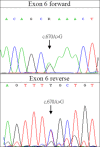Atypical presentation of dopa-responsive dystonia in Taiwan
- PMID: 29484265
- PMCID: PMC5822572
- DOI: 10.1002/brb3.906
Atypical presentation of dopa-responsive dystonia in Taiwan
Abstract
The typical clinical presentation of dopa-responsive dystonia, which is also called Segawa disease, is a young age of onset, with predominance in females, diurnal fluctuation of lower limb dystonia, and fair response to low-dose levodopa. This disease has both autosomal dominant and autosomal recessive inheritance. Autosomal dominant Segawa disease is caused by GCH1 mutation on chromosome 14q22.1-q22.2. Here, we report the case of a male patient with genetically confirmed Segawa disease and atypical presentations including no diurnal symptom fluctuation and insufficient response to levodopa. The patient's father who had the same mutation presented parkinsonism in old age. We also review the literature to address the broad clinical heterogeneity of Segawa disease and the influence of onset age on clinical presentation.
Keywords: Segawa disease; atypical presentation; dopa‐responsive dystonia; onset age; parkinsonian.
Figures



Similar articles
-
A novel missense mutation in GCH1 gene in a Korean family with Segawa disease.Brain Dev. 2015 Mar;37(3):359-61. doi: 10.1016/j.braindev.2014.05.008. Epub 2014 Jun 16. Brain Dev. 2015. PMID: 24948553
-
A novel missense mutation of the GTP cyclohydrolase 1 gene in a Taiwanese family with dopa-responsive dystonia: A case report.Clin Neurol Neurosurg. 2018 Feb;165:21-23. doi: 10.1016/j.clineuro.2017.12.018. Epub 2017 Dec 26. Clin Neurol Neurosurg. 2018. PMID: 29289916
-
Exhaustive analysis of BH4 and dopamine biosynthesis genes in patients with Dopa-responsive dystonia.Brain. 2009 Jul;132(Pt 7):1753-63. doi: 10.1093/brain/awp084. Epub 2009 Jun 2. Brain. 2009. PMID: 19491146
-
GTP Cyclohydrolase 1-Deficient Dopa-Responsive Dystonia.2002 Feb 21 [updated 2019 Jan 24]. In: Adam MP, Feldman J, Mirzaa GM, Pagon RA, Wallace SE, Amemiya A, editors. GeneReviews® [Internet]. Seattle (WA): University of Washington, Seattle; 1993–2025. 2002 Feb 21 [updated 2019 Jan 24]. In: Adam MP, Feldman J, Mirzaa GM, Pagon RA, Wallace SE, Amemiya A, editors. GeneReviews® [Internet]. Seattle (WA): University of Washington, Seattle; 1993–2025. PMID: 20301681 Free Books & Documents. Review.
-
Segawa's disease: dopa-responsive dystonia.Int J Clin Pract. 2008 Jun;62(6):943-6. doi: 10.1111/j.1742-1241.2007.01319.x. Epub 2007 Oct 29. Int J Clin Pract. 2008. PMID: 17971156 Review.
Cited by
-
Segawa Syndrome, a Dramatic Response to Dopamine.Case Rep Neurol Med. 2024 Mar 31;2024:8154006. doi: 10.1155/2024/8154006. eCollection 2024. Case Rep Neurol Med. 2024. PMID: 38590786 Free PMC article.
-
Relevance of Fluorodopa PET Scan in Dopamine Responsive Dystonia and Juvenile Parkinsonism: A Systematic Review.Neurol Int. 2022 Dec 2;14(4):997-1006. doi: 10.3390/neurolint14040079. Neurol Int. 2022. PMID: 36548184 Free PMC article. Review.
-
Case Report: Guitarist's cramp as the initial manifestation of dopa-responsive dystonia with a novel heterozygous GCH1 mutation.F1000Res. 2021 May 7;10:361. doi: 10.12688/f1000research.51433.1. eCollection 2021. F1000Res. 2021. PMID: 34394914 Free PMC article.
-
Recognizing Atypical Dopa-Responsive Dystonia and Its Mimics.Neurol Clin Pract. 2021 Dec;11(6):e876-e884. doi: 10.1212/CPJ.0000000000001125. Neurol Clin Pract. 2021. PMID: 34992971 Free PMC article. Review.
-
Inherited metabolic diseases mimicking hereditary spastic paraplegia (HSP): a chance for treatment.Neurogenetics. 2022 Jul;23(3):167-177. doi: 10.1007/s10048-022-00688-3. Epub 2022 Apr 9. Neurogenetics. 2022. PMID: 35397036 Review.
References
-
- Bandmann, O. , Marsden, C. D. , & Wood, N. W. (1998). Atypical presentations of dopa‐responsive dystonia. Advances in Neurology, 78, 283–290. - PubMed
-
- Bandmann, O. , Nygaard, T. G. , Surtees, R. , Marsden, C. D. , Wood, N. W. , & Harding, A. E. (1996). Dopa‐responsive dystonia in British patients: New mutations of the GTP‐cyclohydrolase I gene and evidence for genetic heterogeneity. Human Molecular Genetics, 5, 403–406. https://doi.org/10.1093/hmg/5.3.403 - DOI - PubMed
-
- Cai, C. , Shi, W. , Zeng, Z. , Zhang, M. , Ling, C. , Chen, L. , … Li, W. D. (2013). GTP cyclohydrolase I and tyrosine hydroxylase gene mutations in familial and sporadic dopa‐responsive dystonia patients. PLoS ONE, 8, e65215 https://doi.org/10.1371/journal.pone.0065215 - DOI - PMC - PubMed
-
- Cao, L. , Zheng, L. , Tang, W. G. , Xiao, Q. , Zhang, T. , Tang, H. D. , … Chen, S. D. (2010). Four novel mutations in the GCH1 gene of Chinese patients with dopa‐responsive dystonia. Movement Disorders, 25, 755–760. https://doi.org/10.1002/mds.22646 - DOI - PubMed
Publication types
MeSH terms
Substances
Supplementary concepts
LinkOut - more resources
Full Text Sources
Other Literature Sources
Medical

